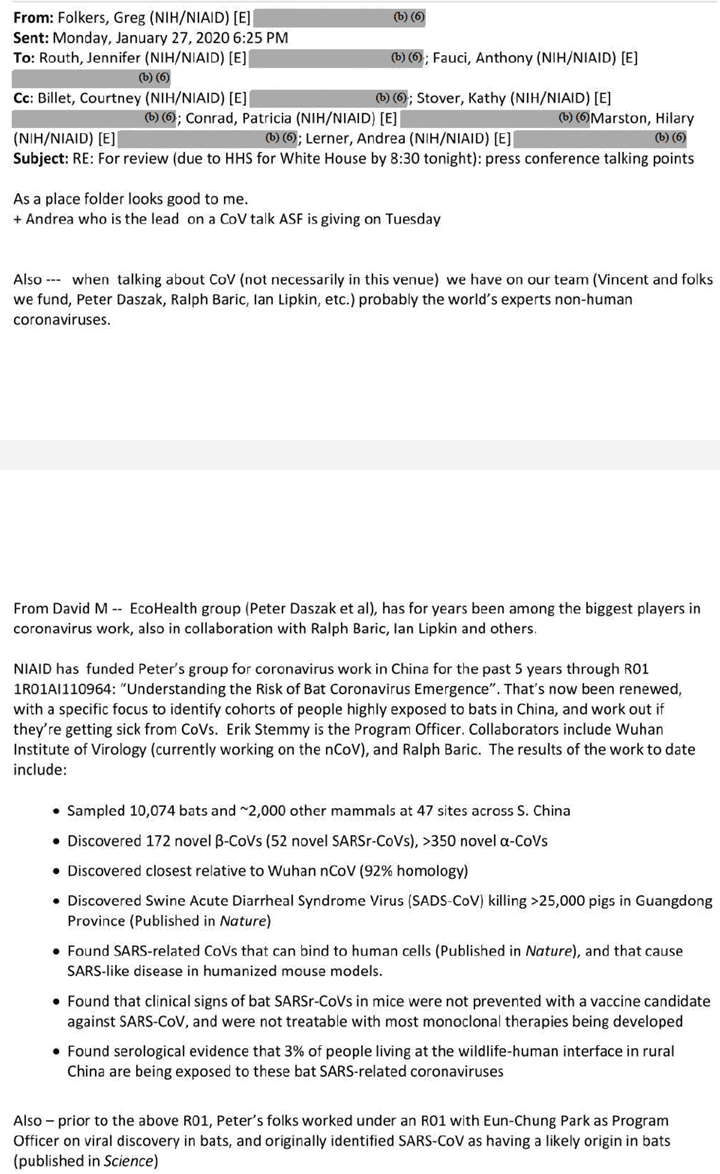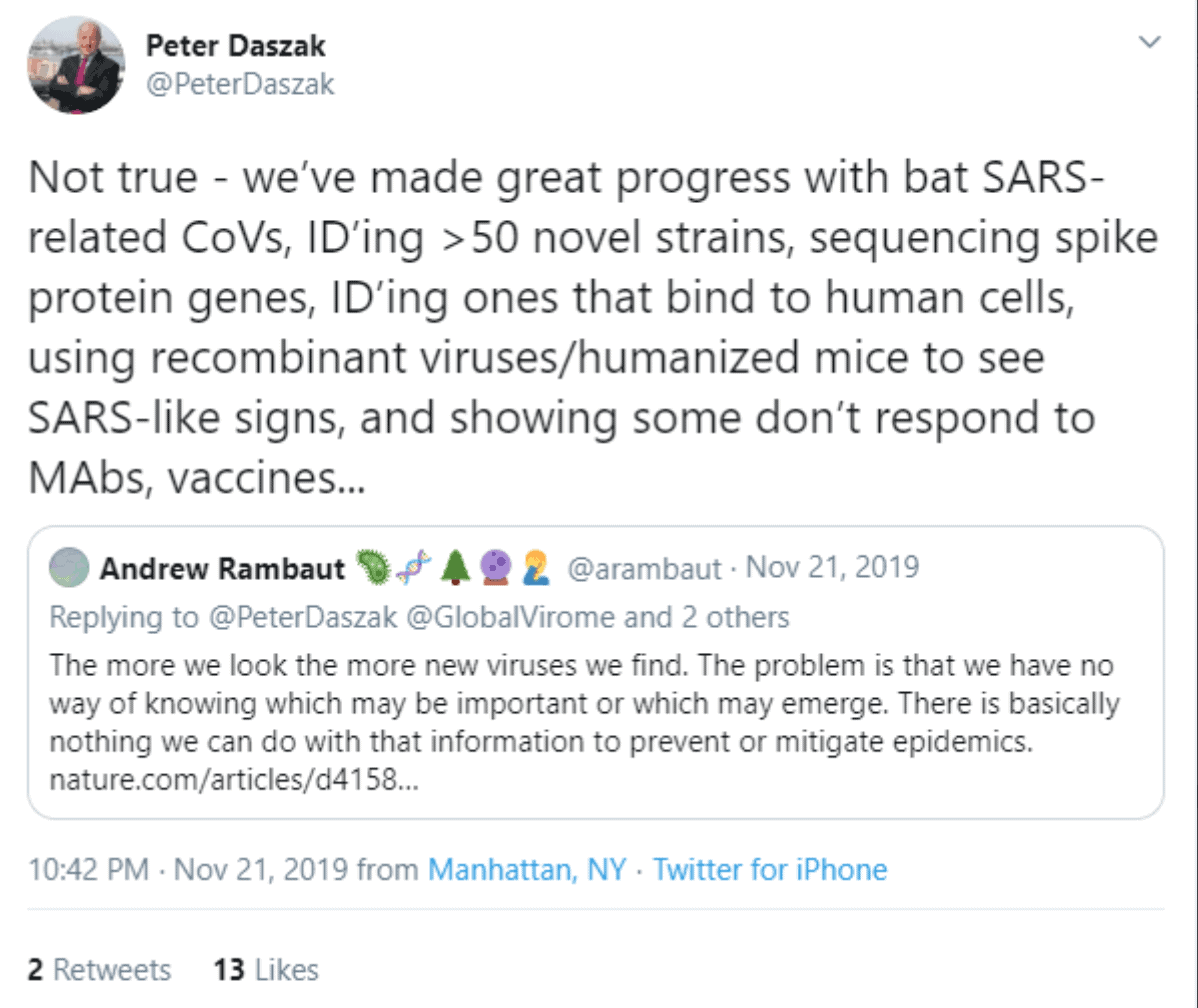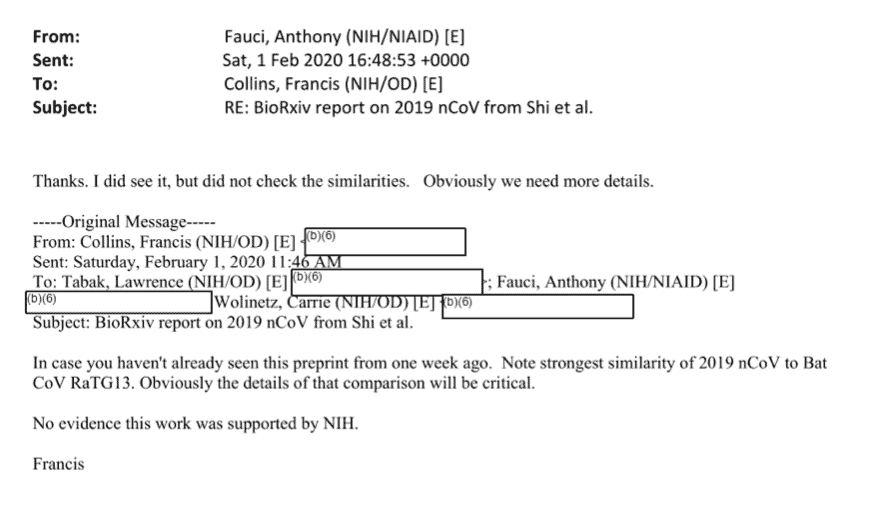Anthony Fauci, a leader of the U.S. response to the coronavirus pandemic and one of the most influential scientists in infectious diseases research for decades, knew in extraordinary detail the breadth of novel coronavirus research underway in Wuhan, China, within a month of the globe learning of the Wuhan novel coronavirus.
Fauci had been informed by January 2020 that his institute had funded the discovery and study of dozens of novel coronaviruses at the Wuhan Institute of Virology, including the closest cousin virus to SARS-CoV-2, the virus that causes COVID-19, new records show.
A new email obtained through a Freedom of Information Act lawsuit confirms that privately Fauci knew the magnitude of the coronavirus research going on at the coronavirus pandemic’s epicenter, even while publicly shrugging off suggestions the pandemic began with a research accident as conspiratorial.
This apparent deception has held back the public’s understanding of the matter and hindered independent investigations into the source of the worst pandemic in a century.
In an email dated January 27, 2020, Fauci received talking points for a press availability that evening. An aide laid out in detail the research at the Wuhan lab funded by the National Institute of Allergy and Infectious Diseases — the institute Fauci steered for decades.
Through the nonprofit EcoHealth Alliance, its president Peter Daszak and its contracted lab, the Wuhan Institute of Virology, NIAID had funded the discovery of 52 novel sarbecoviruses, or coronaviruses related to SARS — the species that SARS-CoV-2 belongs to.
These included the closest known relative of the “nCoV,” or novel coronavirus, quickly spreading around the globe.
“EcoHealth group (Peter Daszak et al), has for years been among the biggest players in coronavirus work, also in collaboration with Ralph Baric, Ian Lipkin and others,” wrote Fauci’s chief of staff Greg Folkers.

NIAID did not respond to a request for comment.
EcoHealth and its partner lab had sampled from 47 sites across South China, where the closest relatives to SARS-CoV-2 circulate. With funding from Fauci’s institute, virus hunters sampled more than 10,000 bats and around 2,000 other mammals whose species are not specified, Folkers reported.
Research by University of North Carolina coronavirologist Ralph Baric had found that some of these coronaviruses could bind to ACE2, a receptor on cells found in the lungs, heart and blood vessels.
Folkers did not explicitly mention gain-of-function research — experiments that make viruses more transmissible or deadly in the lab.
But Folkers did mention that the novel coronaviruses had been found to cause SARS-like disease in “humanized mouse models.”
Labs may use mice engineered to express humanized lung cells to conduct viral experiments. In a method called serial passage, virologists can speed up a virus’ evolution by inducing successive infections, enhancing a virus’ ability to infect these cells.
A week later, Fauci appeared to express alarm at the possibility that SARS-CoV-2 arose through this method.
Fauci had been alerted by a group of scientists that the virus appeared “inconsistent with expectations from evolutionary theory” — in other words, lab made.
Fauci had requested a group of virologists examine the data.
Fauci assigned another aide, NIAID Deputy Director Hugh Auchincloss, to investigate NIH connections to the research. In his message to Auchincloss, he sent a link to the Nature paper coauthored by Baric mentioned in the Jan. 27 email. Baric had shared mice engineered to express ACE2 with the Wuhan lab. This technology was then shared more widely among scientists in China, which had apparently alarmed Baric, according to other emails obtained through a freedom of information request.
Privately, the virologists looking at the data expressed alarm that the virus appeared “locked and loaded” for ACE2.
“I’d be interested in the proposal of accidental lab passage in animals (which ones?),” Francis Collins, then the director of the National Institutes of Health, asked.
“?? Serial passage in ACE2 mice,” Fauci wrote in an email eight days later.
Fauci met with Baric a few days later, on Feb. 11, about engineered viruses.
Publicly, Fauci and other critics of the lab leak theory have downplayed the significance of the virus emerging from the city where this coronavirus research was conducted — pointing to the fact that there are other virology labs in China.
Yet the Jan. 27, 2020, email suggests that the lab complex in Wuhan was conducting some of the world’s most cutting edge coronavirus research.
The new email demonstrates that Fauci’s top aide pointed to Daszak, Baric and Lipkin early on as “probably the world’s experts in non-human coronaviruses” and “among the biggest players in coronavirus work.”
Fauci could have said more
Months and years elapsed before much of the public became aware of that there was a library of novel coronaviruses in Wuhan discovered with U.S. aid across South China, where the closest relatives of SARS-CoV-2 circulate.
The new email corroborates a November 2019 tweet by Daszak saying his organization had discovered more than 50 coronavirus strains related to SARS, discovered some of them could bind to human cells, and had used engineered viruses and humanized mice to study them.
The fact that the Wuhan lab and its American partner were sampling thousands of bats across 47 sites in Southern China has also been corroborated by EcoHealth Alliance grant reports submitted to the NIH and obtained under FOIA.
Grant reports show that some sites were described as containing a “rich pool of undiscovered SARS-related coronaviruses,” particularly in Yunnan Province.

RaTG13
The email also points to a connection between NIH and SARS-CoV-2’s closest cousin virus, RaTG13.
The new email states that the bat virus discovered with NIH help is 92 percent similar to SARS-CoV-2, while RaTG13 is 96 percent similar across its genome. It’s not clear whether this is a mistake or refers to a different virus.
It is clear that a preprint authored by Wuhan Institute of Virology Senior Scientist Shi Zhengli about the similarity between SARS-CoV-2 and the bat virus it discovered, RaTG13, published on January 24, 2020, set off major alarm bells among the leaders of the NIH.
An email previously reported by U.S. Right to Know indicates that Collins and Fauci were concerned in February 2020 about whether NIH could be traced to Wuhan Institute of Virology Senior Scientist Zhengli Shi’s research shortly after she published a preprint about RaTG13.
“Note strongest similarity of 2019 nCoV to Bat Cov RaTG13. Obviously the details of that comparison will be critical,” Collins wrote to Fauci on February 1, 2020. “No evidence this work was supported by NIH.”

In fact, NIH had supported the work, according to public papers and the Jan. 27 email to Fauci.
Yet it took online sleuths to uncover the provenance of this close cousin virus to SARS-CoV-2 discovered with NIH help, including its possible relationship to a mysterious illness that affected bat guano miners in 2012.
‘From David M’
The information relayed to Fauci in the Jan. 27 email appears to have been sourced from “David M,” a possible reference to Fauci’s senior advisor David Morens.
Morens, another top aide to Fauci, came under congressional scrutiny earlier this year when emails obtained through a congressional subpoena showed that he was in communication with Daszak about pushing back on stories in the press about the lab leak theory.
“Do not rule out suing these assholes for slander,” Morens wrote to Daszak. Scientists looped in on the email included virologists who have cast the lab leak theory as a conspiracy theory in papers and in the media.
Morens also spoke to the media about the origins question at Fauci’s request, saying, “Tony doesn’t want his fingerprints on origin stories.”
The emails also showed that he said he sought to evade FOIA requests by using his personal email address.
“I try to always communicate on gmail because my NIH email is FOIA’d constantly,” Morens said in a September 2019 email. “I will delete anything I don’t want to see in the New York Times.”
The emails prompted letters from congressional investigators and the National Archives and Records Administration.
While his deputies appeared more informed about EcoHealth Alliance’s work in the Jan. 27 email, Fauci’s championing of gain-of-function studies — despite the concerns of scientists who questioned the utility and risk — may have contributed to its prestige.
Folkers noted in the Jan. 27, 2020, email that EcoHealth Alliance’s work on coronaviruses had been published in two of the top scientific journals in the world: Nature and Science.
U.S. Right to Know obtained the email used in this story through a Freedom of Information Act lawsuit against the National Institutes of Health.